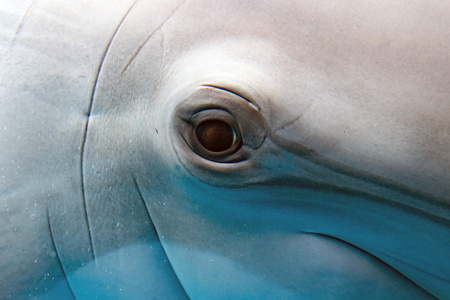dolphins.html">Dolphins are some of the most intelligent and beloved creatures in the ocean, known for their playful behavior and social nature. But have you ever wondered, where are a dolphin's eyes located and how their unique anatomy contributes to their ability to navigate the seas so gracefully? This article will dive deep into dolphin anatomy, focusing on their eye placement, vision, and how these factors help them survive in their underwater world.

Dolphins, like many marine mammals, have their eyes positioned on either side of their heads. This lateral placement of the eyes allows them to have a wide field of vision, which is crucial for their survival in the open ocean. While their eyes are separated and face outward, they still have the ability to focus on objects in front of them, though not as precisely as animals with front-facing eyes, like humans.
This eye placement gives dolphins a nearly 360-degree view of their surroundings, helping them spot predators, prey, and other members of their pod. However, there is a small blind spot directly in front of their snout and directly behind their tail. Despite this, dolphins have evolved to navigate their environment with incredible efficiency using both their vision and other senses, which we’ll explore in the following sections.
Dolphin eyes are highly specialized for underwater vision, and their ability to adapt to different light conditions is remarkable. Here’s a breakdown of how their vision works:
Dolphins are primarily adapted to see underwater. Their eyes have a spherical lens that helps them focus on objects in a marine environment. Unlike humans, whose eyes struggle to focus underwater without goggles, dolphins can maintain sharp vision while submerged.
Although dolphins are optimized for underwater sight, they can still see above the water's surface. This is crucial for their behavior, as they often leap and swim near the surface. However, their vision above water is not as sharp as it is underwater, because the difference in refraction between air and water affects their ability to focus.
It is believed that dolphins have limited color vision. Research suggests that dolphins may see in shades of blue and green, which are the most prevalent colors in the ocean. Their color perception might be reduced compared to humans, but it is sufficient for detecting prey and navigating their surroundings.
Dolphins are also capable of seeing in low-light conditions. Their eyes have a tapetum lucidum, a reflective layer behind the retina that enhances their ability to see in dim light. This feature is shared by many nocturnal animals and helps dolphins hunt during the night or in deeper, darker waters.
Dolphins use a combination of their eyes and other senses, particularly echolocation, to navigate the ocean. Echolocation is a process where dolphins emit high-pitched sounds and listen for the echoes that bounce back from objects in their environment. This ability allows them to "see" with sound, giving them an extraordinary edge in murky waters or areas with limited visibility.
While their eyes provide a wide field of vision, echolocation fills in the gaps where visual information may be lacking. This dual-sensory system enables dolphins to detect prey, avoid obstacles, and communicate with one another, even in complete darkness or turbulent waters.
The positioning of a dolphin’s eyes plays a key role in its ability to survive and thrive in the ocean. Here are some of the ways this unique eye placement benefits them:
Spotting Predators: Dolphins are preyed upon by larger aquarium/52-marine-animals.html">marine animals like sharks and killer whales (orcas). With eyes on the sides of their heads, dolphins can quickly detect approaching predators from a wide range of angles and make swift escapes.
Tracking Prey: Dolphins hunt small fish and squid, often in groups. Their wide field of vision helps them track the movement of prey in all directions, improving their success during hunts.
Social Interaction: Dolphins are highly social animals, often swimming in pods. Their wide vision allows them to keep track of pod members, maintain group cohesion, and communicate effectively with visual signals such as body movements and gestures.
While dolphin eyes are remarkable, their other senses play a vital role in their survival:
Echolocation: As previously mentioned, dolphins use echolocation to "see" in ways that go beyond their vision. This sense is so finely tuned that dolphins can detect the size, shape, and even the internal structure of objects underwater.
Hearing: Dolphins have an acute sense of hearing, which is particularly important for their echolocation abilities. They can hear frequencies far beyond the range of human hearing, enabling them to detect sounds from miles away.
Touch: Dolphins have a well-developed sense of touch, particularly around their heads and blowholes. This sensitivity helps them in social interactions and maintaining their position within a pod.
Dolphins are not the only marine mammals with lateral eye placement. Many species, such as whales and porpoises, share similar eye positioning, designed to maximize their field of view in the ocean. However, dolphins' agility and speed make their eye placement particularly advantageous for spotting fast-moving prey and avoiding danger in their high-energy environments.
So, where are a dolphin's eyes located? On the sides of their heads, providing them with a wide, nearly 360-degree view of their surroundings. While this placement leaves small blind spots, dolphins more than make up for it with their keen echolocation abilities and sharp underwater vision. Their unique anatomy, including their eye placement, plays a crucial role in their success as hunters, navigators, and social animals in the vast oceans.
Understanding the intricacies of dolphin anatomy, particularly their vision, highlights just how well-adapted these intelligent creatures are to their environment. The next time you see a dolphin leaping through the waves, you can appreciate the complex visual and sensory systems that allow them to navigate the underwater world with such grace and precision.
animal tags: dolphin
We created this article in conjunction with AI technology, then made sure it was fact-checked and edited by a Animals Top editor.